Identifying the Inertial Properties of a Padel Racket: An Experimental Maneuverability Proposal
Abstract
1. Introduction
2. Measurement Process
2.1. Preliminary Measurements
2.2. MOI Calculation Methods
2.3. Comparison of the Approaches
2.4. Test Stand Design and Implementation
2.5. Sensor Data Processing
- Raw sensor data are noisy and coarse, so signals are filtered first with low pass at 1500 Hz and second with a simple moving average. It replaces every data point by the mean of its initial value and the value of the preceding and the following two data points. Filters reduce the noise, and the leaps in the signal are smoothed out, as shown in Figure 10.
- The signal is trimmed (Figure 10b) to consider only a whole multiple of the repetitive period. That means that the dataset starts at the same point of the period where it ends. An offset is applied to the data so that the mean of the values is just zero. After that, complete cycles can be detected by searching for the points where the sign changes from positive to negative or vice versa.
- It shows the frequency spectra (Figure 11). After obtaining the dominating frequency, the period determines the time of an entire cycle.
2.6. Interface Design Software
3. Calibration, Testing, and Error Estimation
3.1. Propagation of Error and Repeatability for Horizontal Rotation
3.2. Propagation of Error and Repeatability for Vertical Rotation
3.3. Summary on Error Estimation and Considerations
- Some rackets are manipulated with extra grips or protectors on the side. These items change the weight and balance point.
- The variance of the parameters between rackets of the same model is significant. Some manufacturers specify the weight of the rackets with a range of 20 g, which causes a variance that makes it impossible to generalize the results for all rackets of the same model accurately.
- The handle end of some models is oddly shaped or has a strap attached, making it difficult to accurately measure the distance to the COM and position the racket in the cradle.
- Even though ball bearings used in the horizontal pendulum have low friction, this friction damping the swing, and, after approximately ten cycles, the padel rackets stop due to the friction force.
- In the case of the vertical rotation axis, the rotation goes not precisely through the COM; since the thickness of the padel rackets varies, the axes do not always coincide.
- The trifilar vertical pendulum achieves worse results than the horizontal pendulum. However, it allows calculating the MOI when the pendulum’s axis passes through the COM of the padel racket, as occurs with the z axis. The trifilar pendulum requires a more complex and heavier cradle to fix the padel racket, the slight deviations between the pendulum axis and the distance to the COM influence the result. The initial manual impulse given to the trifilar pendulum makes it not only oscillate around its vertical axis, creating an overlapping of harmonic movements with different frequencies that add error to the measurement. The horizontal pendulum is an effortless and reliable design, but it only can be used when the axis of rotation of the pendulum and the COM are significantly separated.
4. Experiments and Results
4.1. Correlation between Values
4.2. Maneuverability Parameter
5. Study with Padel Users
5.1. The Procedure of the Study
5.2. Results of the Study
6. Conclusions and Future Work
Author Contributions
Funding
Informed Consent Statement
Acknowledgments
Conflicts of Interest
References
- Courel-Ibáñez, J.; Herrera-Gálvez, J.J. Fitness Testing in Padel: Performance Differences According to Players’ Competitive Level. Sci. Sports 2020, 35, e11–e19. [Google Scholar] [CrossRef]
- Harding, N. Anyone for a Game of Padel? Meet the Tennis-like Sport Even Andy Murray Can’t Resist. Available online: https://www.telegraph.co.uk/health-fitness/body/anyone-game-padel-meet-tennis-like-sport-even-andy-murray-cant/ (accessed on 13 September 2022).
- Kelly, G. Padel Power: Will the World’s Fastest-Growing Sport Take off in the UK? Available online: https://www.telegraph.co.uk/health-fitness/body/padel-power-will-the-worlds-fastest-growing-sport-take-off-in-th/ (accessed on 13 September 2022).
- International Padel Federation. 2022 Padel Federations. Available online: https://www.padelfip.com/es/federations/ (accessed on 14 September 2022).
- Escudero-Tena, A.; Sánchez-Alcaraz, B.J.; García-Rubio, J.; Ibáñez, S.J. Analysis of Game Performance Indicators during 2015–2019 World Padel Tour Seasons and Their Influence on Match Outcome. Int. J. Environ. Res. Public Health 2021, 18, 4904. [Google Scholar] [CrossRef]
- Huera-Huarte, F.J. Some Observations on the Flow Physics of Paddle Racquets. Proc. Inst. Mech. Eng. Part P J. Sport. Eng. Technol. 2014, 228, 40–48. [Google Scholar] [CrossRef]
- International Padel Federation. Regulations of the Padel Game. Available online: https://www.padelfip.com/wp-content/uploads/2021/05/2-game-regulations.pdf (accessed on 14 September 2022).
- Grant, R.A.; Taraborrelli, L.; Allen, T. Morphometrics for Sports Mechanics: Showcasing Tennis Racket Shape Diversity. PLoS ONE 2022, 17, e0263120. [Google Scholar] [CrossRef] [PubMed]
- García-Giménez, A.; Pradas de la Fuente, F.; Castellar Otín, C.; Carrasco Páez, L. Performance Outcome Measures in Padel: A Scoping Review. Int. J. Environ. Res. Public Health 2022, 19, 4395. [Google Scholar] [CrossRef] [PubMed]
- Richter, F. Padel: The Biggest Sport You’ve Never Heard of. Available online: https://www.statista.com/chart/18041/growth-of-padel-around-the-world/ (accessed on 13 September 2022).
- Taraborrelli, L.; Choppin, S.; Haake, S.; Mohr, S.; Allen, T. Effect of Materials and Design on the Bending Stiffness of Tennis Rackets. Eur. J. Phys. 2021, 42, 065005. [Google Scholar] [CrossRef]
- Molí Díaz, A.A.; López Taboada, C.; Castillo López, G.; García Sánchez, F. Experimental Numerical Correlation of a Padel Racket Subject to Impact; Editorial Club Universitario: Alicante, Spain, 2019. [Google Scholar]
- Chen, C.-H.; Fan, C.-K.; Hong, T.-P. Construction of an Intelligent Tennis Coach Based on Kinect and a Sensor-Based Tennis Racket. In Proceedings of the 12th Asian Conference on Intelligent Information and Database Systems (ACIIDS), Phuket, Thailand, 23–26 March 2020; pp. 536–544. [Google Scholar]
- Yanan, P.; Jilong, Y.; Heng, Z. Using Artificial Intelligence to Achieve Auxiliary Training of Table Tennis Based on Inertial Perception Data. Sensors 2021, 21, 6685. [Google Scholar] [CrossRef]
- Wang, Y.; Chen, M.; Wang, X.; Chan, R.H.M.; Li, W.J. IoT for Next-Generation Racket Sports Training. IEEE Internet Things J. 2018, 5, 4558–4566. [Google Scholar] [CrossRef]
- Cross, R.; Nathan, M.A. Performance versus Moment of Inertia of Sporting Implements. Sport. Technol. 2009, 2, 7–15. [Google Scholar] [CrossRef]
- Schorah, D.; Choppin, S.; James, D. Effects of Moment of Inertia on Restricted Motion Swing Speed. Sport. Biomech. 2015, 14, 157–167. [Google Scholar] [CrossRef]
- Cross, R. A Double Pendulum Model of Tennis Strokes. Cit. Am. J. Phys. 2011, 79, 330. [Google Scholar] [CrossRef]
- Turner, J.; Forrester, S.E.; Mears, A.C.; Roberts, J.R. Reliability of Repeat Golf Club Testing Sessions with Modified Club Moment of Inertia. Sport. Eng. 2020, 23, 8. [Google Scholar] [CrossRef]
- Curtis, D.; Heller, B.; Senior, T. Methods for Estimating Moment of Inertia of Cricket Bats. Sport. Eng. 2021, 24, 11. [Google Scholar] [CrossRef]
- Allen, T.; Taraborrelli, L.; Grant, R.; Sullivan, M.; Choppin, S.; Spurr, J.; Haake, S. Recommendations for Estimating the Moments of Inertia of a Tennis Racket. Sport. Eng. 2019, 22, 11. [Google Scholar] [CrossRef]
- Brody, H. Physics of the Tennis Racket. Am. J. Phys. 1979, 47, 482–487. [Google Scholar] [CrossRef]
- Brody, H. The Moment of Inertia of a Tennis Racket. Phys. Teach. 1985, 23, 213–216. [Google Scholar] [CrossRef]
- Rogowski, I.; Creveaux, T.; Chèze, L.; Macé, P.; Dumas, R. Effects of the Racket Polar Moment of Inertia on Dominant Upper Limb Joint Moments during Tennis Serve. PLoS ONE 2014, 9, e104785. [Google Scholar] [CrossRef] [PubMed]
- Connor, T.A.; Stewart, M.; Burek, R.; Gilchrist, M.D. Influence of Headform Mass and Inertia on the Response to Oblique Impacts. Int. J. Crashworthiness 2019, 24, 677–698. [Google Scholar] [CrossRef]
- Allen, T.; Grant, R.; Sullivan, M.; Taraborrelli, L.; Choppin, S.; Spurr, J.; Haake, S. Recommendations for Measuring Tennis Racket Parameters. Proceedings 2018, 2, 263. [Google Scholar] [CrossRef]
- Spurr, J.; Goodwill, S.; Kelley, J.; Haake, S. Measuring the Inertial Properties of a Tennis Racket. Procedia Eng. 2014, 72, 569–574. [Google Scholar] [CrossRef]
- Wang, S.Y.; Huang, C. Effects of Using Different Moment of Inertia of Racket on Tennis Serve. In Proceedings of the 19 International Symposium on Biomechanics in Sport, San Francisco, CA, USA; 2001; pp. 39–42. [Google Scholar] [CrossRef]
- Mitchell, S.R.; Jones, R.; King, M. Head Speed vs. Racket Inertia in the Tennis Serve. Sport. Eng. 2000, 3, 99–110. [Google Scholar] [CrossRef]
- Hou, Z.-C.; Lu, Y.; Lao, Y.; Liu, D. A New Trifilar Pendulum Approach to Identify All Inertia Parameters of a Rigid Body or Assembly. Mech. Mach. Theory 2009, 44, 1270–1280. [Google Scholar] [CrossRef]
- du Bois, J.L.; Lieven, N.A.J.; Adhikari, S. Error Analysis in Trifilar Inertia Measurements. Exp. Mech. 2009, 49, 533–540. [Google Scholar] [CrossRef]
- Korr, A.L.; Hyer, P. A Trifilar Pendulum for the Determination Moments of Inertia; Pitman-Dunn Research Labs: Philadelphia, PA, USA, 1962. [Google Scholar]
- Andriulli, J.B. A Simple Rotational Pendulum Method to Measure the Radii of Gyration or Mass Moments of Inertia of a Rotor and Other Assemblies; Oak Ridge National Laboratory: Oak Ridge, TN, USA, 1997. [Google Scholar]
- Dowling, J.J.; Durkin, J.L.; Andrews, D.M. The Uncertainty of the Pendulum Method for the Determination of the Moment of Inertia. Med. Eng. Phys. 2006, 28, 837–841. [Google Scholar] [CrossRef] [PubMed]
- Tang, L.; Shangguan, W.-B. An Improved Pendulum Method for the Determination of the Center of Gravity and Inertia Tensor for Irregular-Shaped Bodies. Measurement 2011, 44, 1849–1859. [Google Scholar] [CrossRef]
- Raven, G. Prince Precision Tuning Center—Tennis Industry. Available online: http://www.tennisindustrymag.com/articles/2006/04/prince_precision_tuning_center.html (accessed on 13 September 2022).
- Devices, A. Accelerometer AD22293. Available online: www.analog.com (accessed on 17 November 2022).
- USB-6008 Specifications—NI. Available online: https://www.ni.com/docs/en-US/bundle/usb-6008-specs/page/specs.html (accessed on 17 November 2022).
- Pal, D.; Gaberson, H.A. Surmounting the Inherent Errors in the Trifilar Pendulum Measurement of Moment of Inertia. J. Acoust. Soc. Am. 1973, 54, 292. [Google Scholar] [CrossRef]
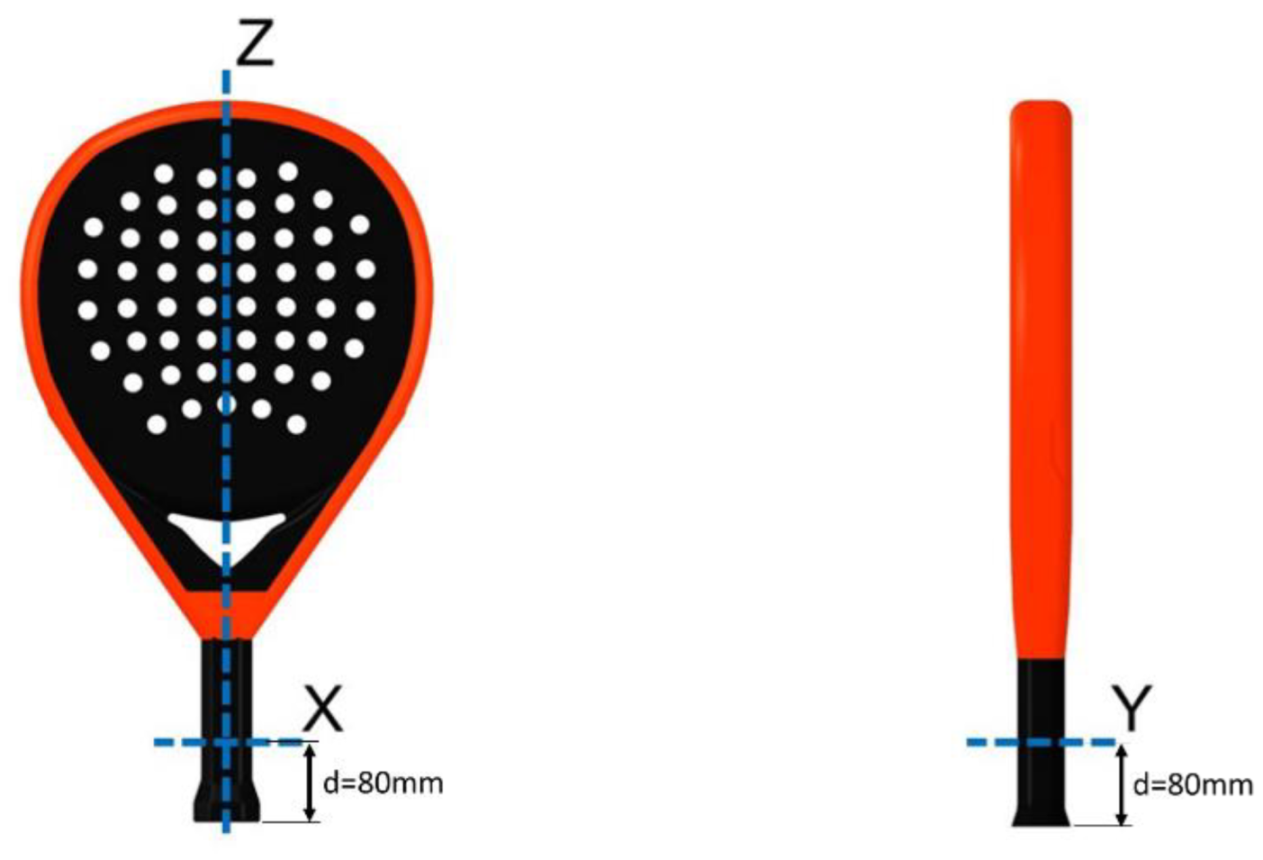


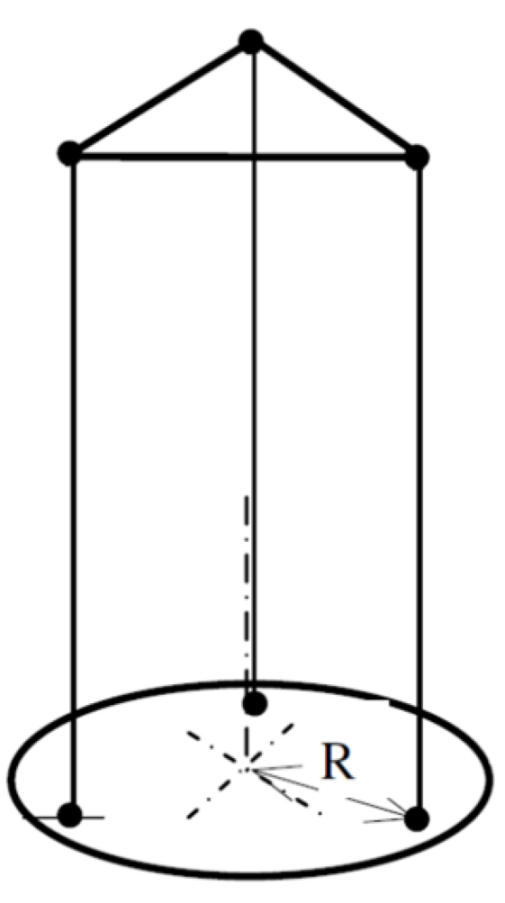
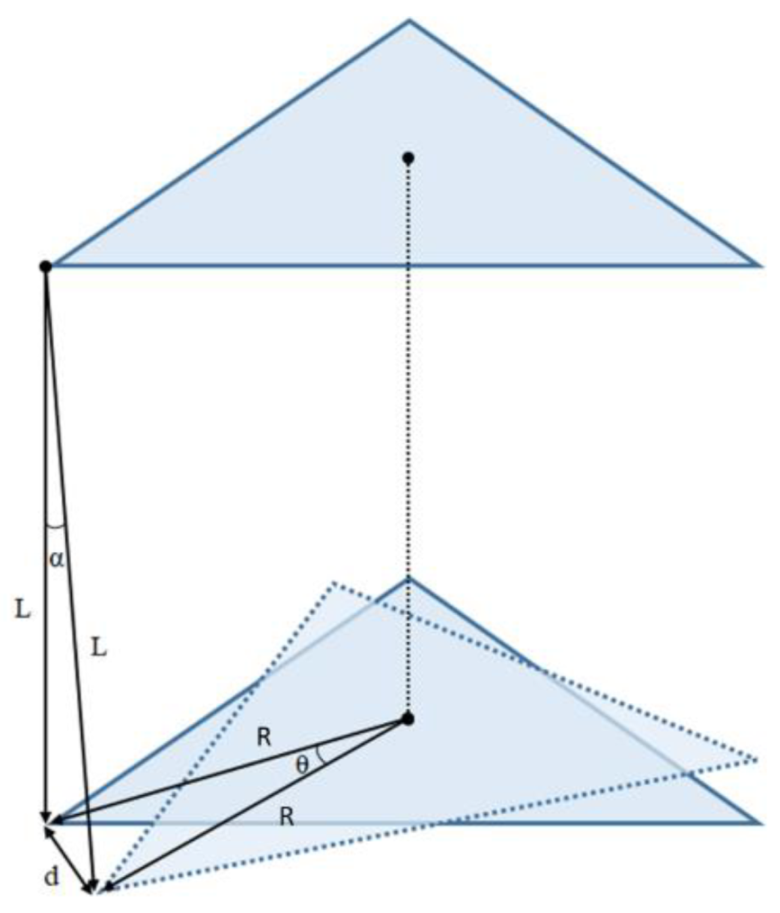
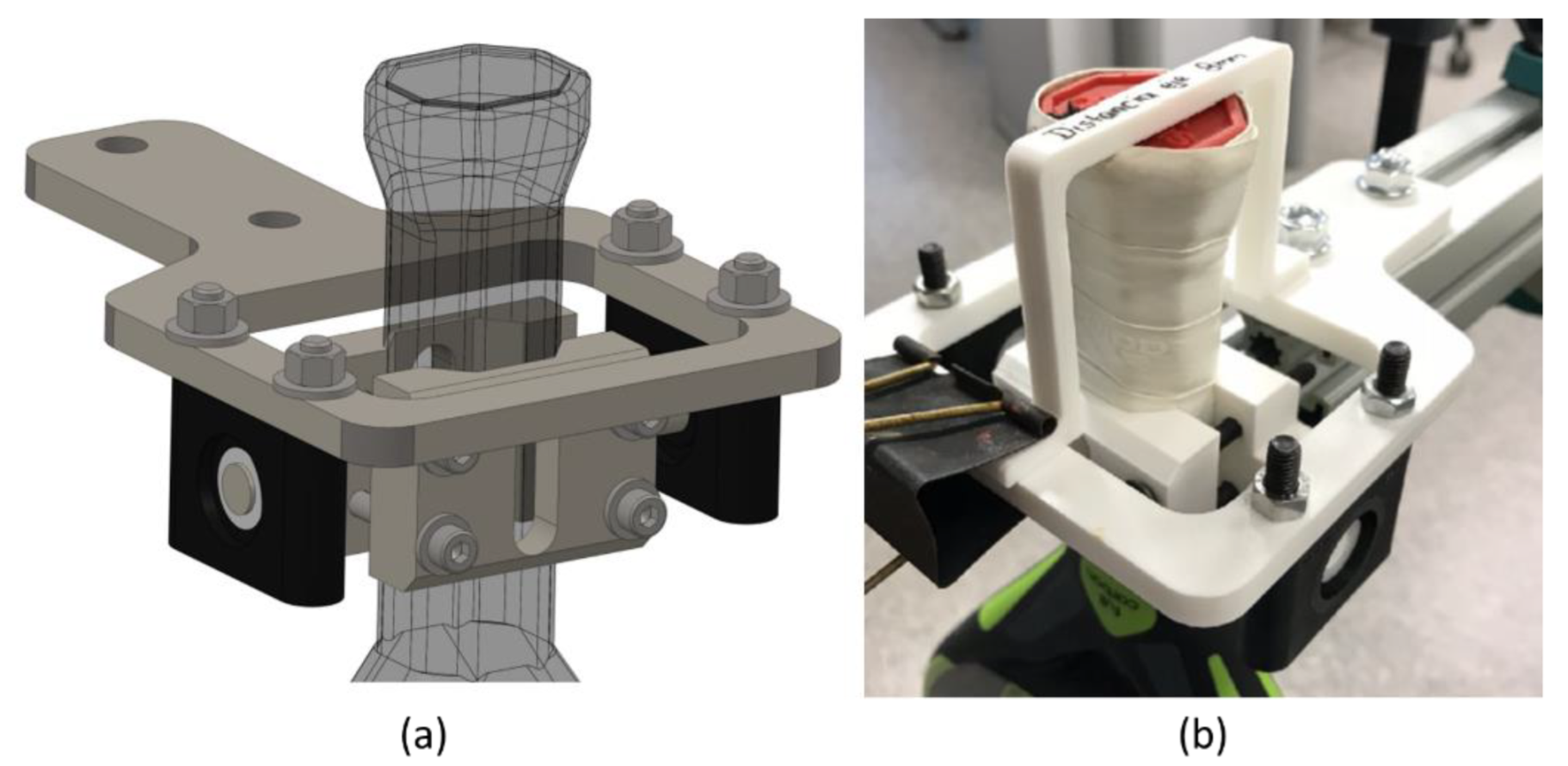

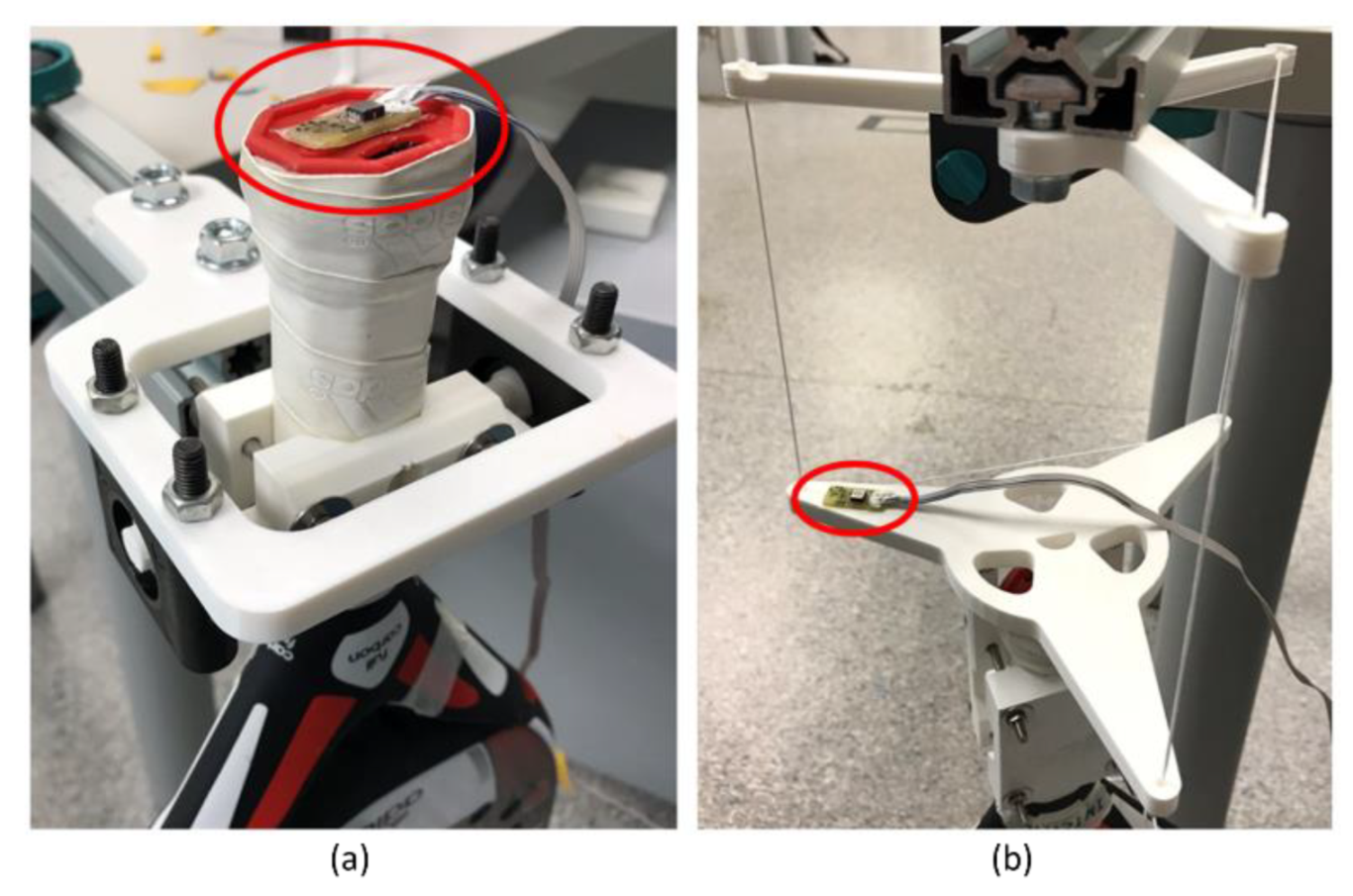


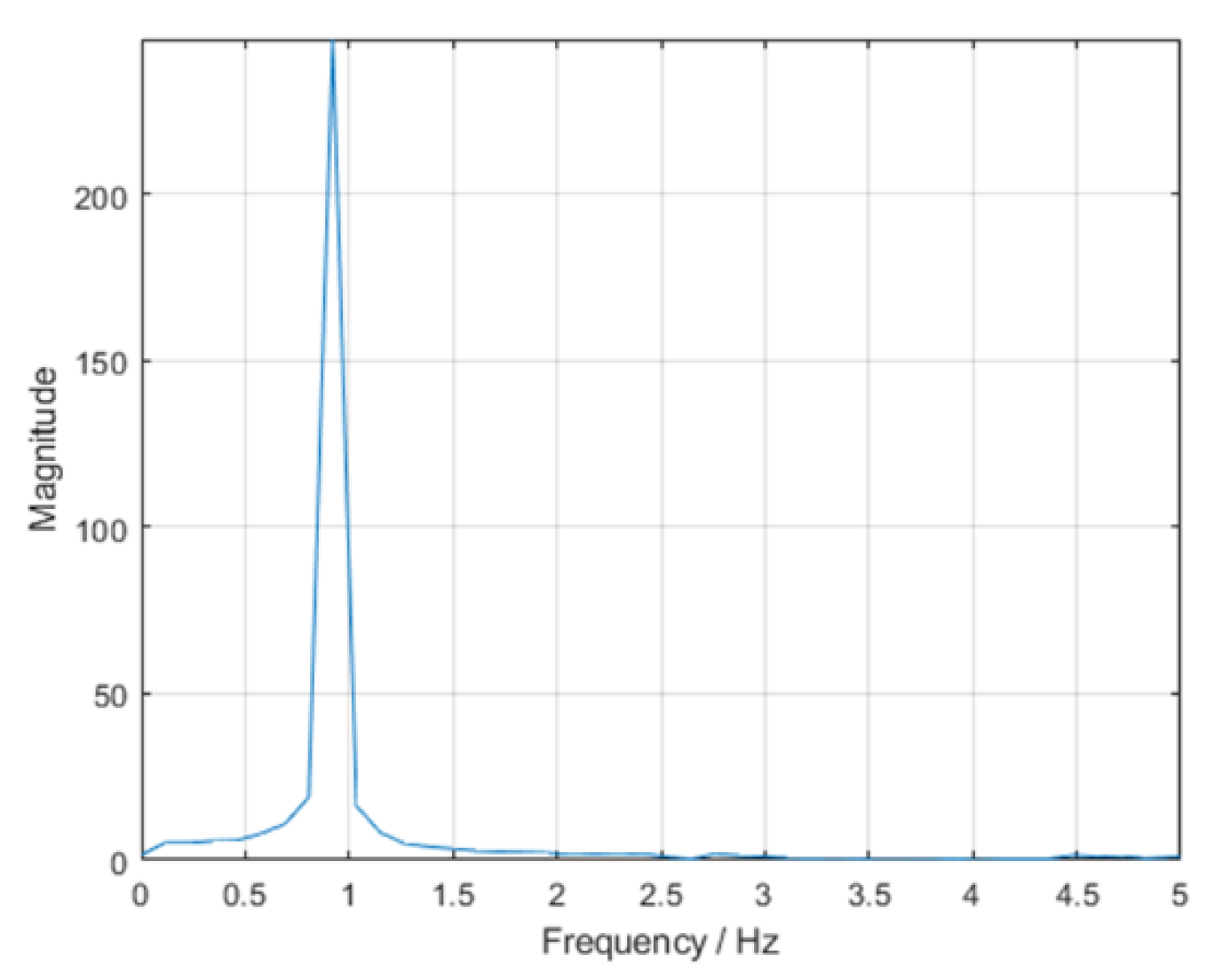
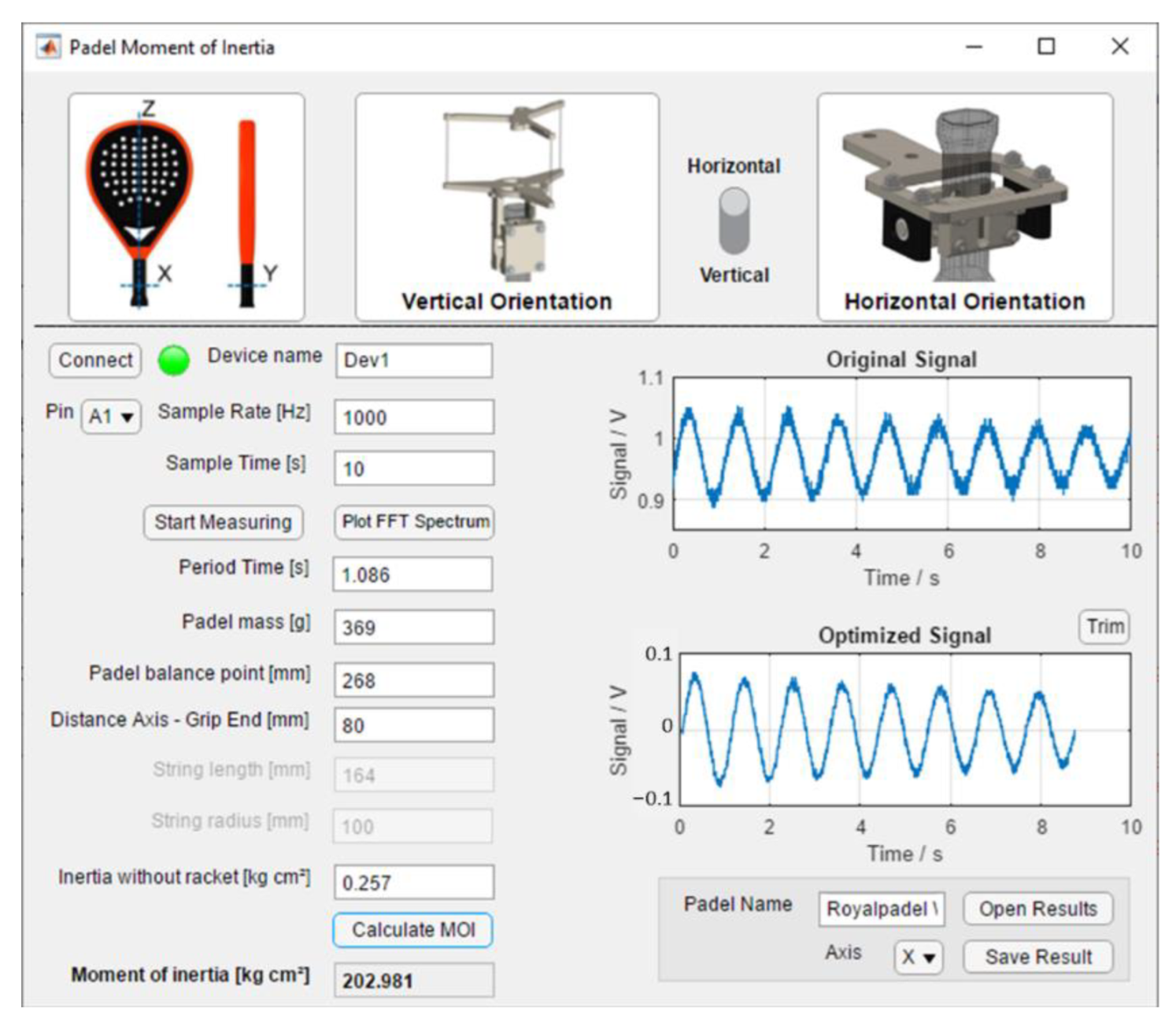
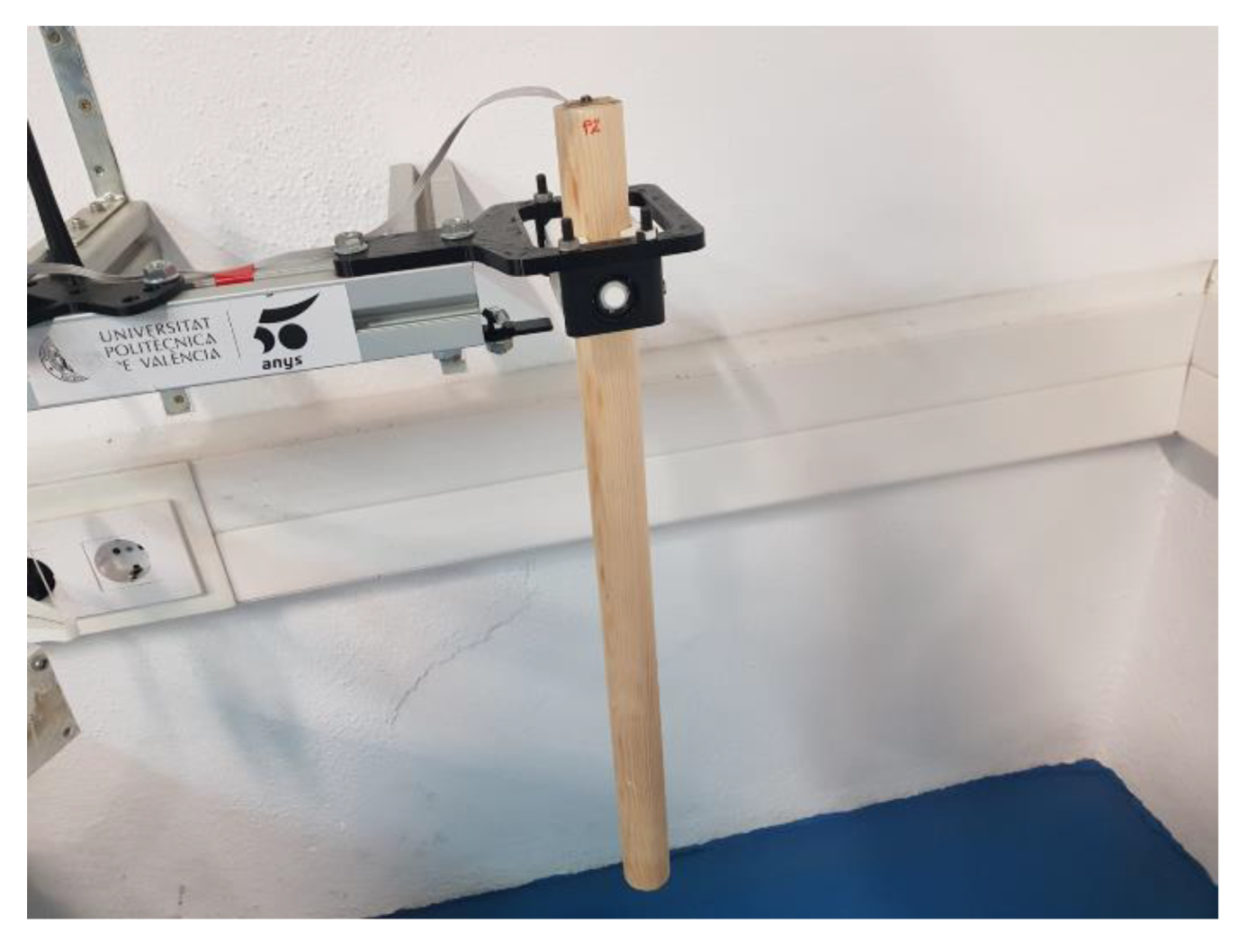
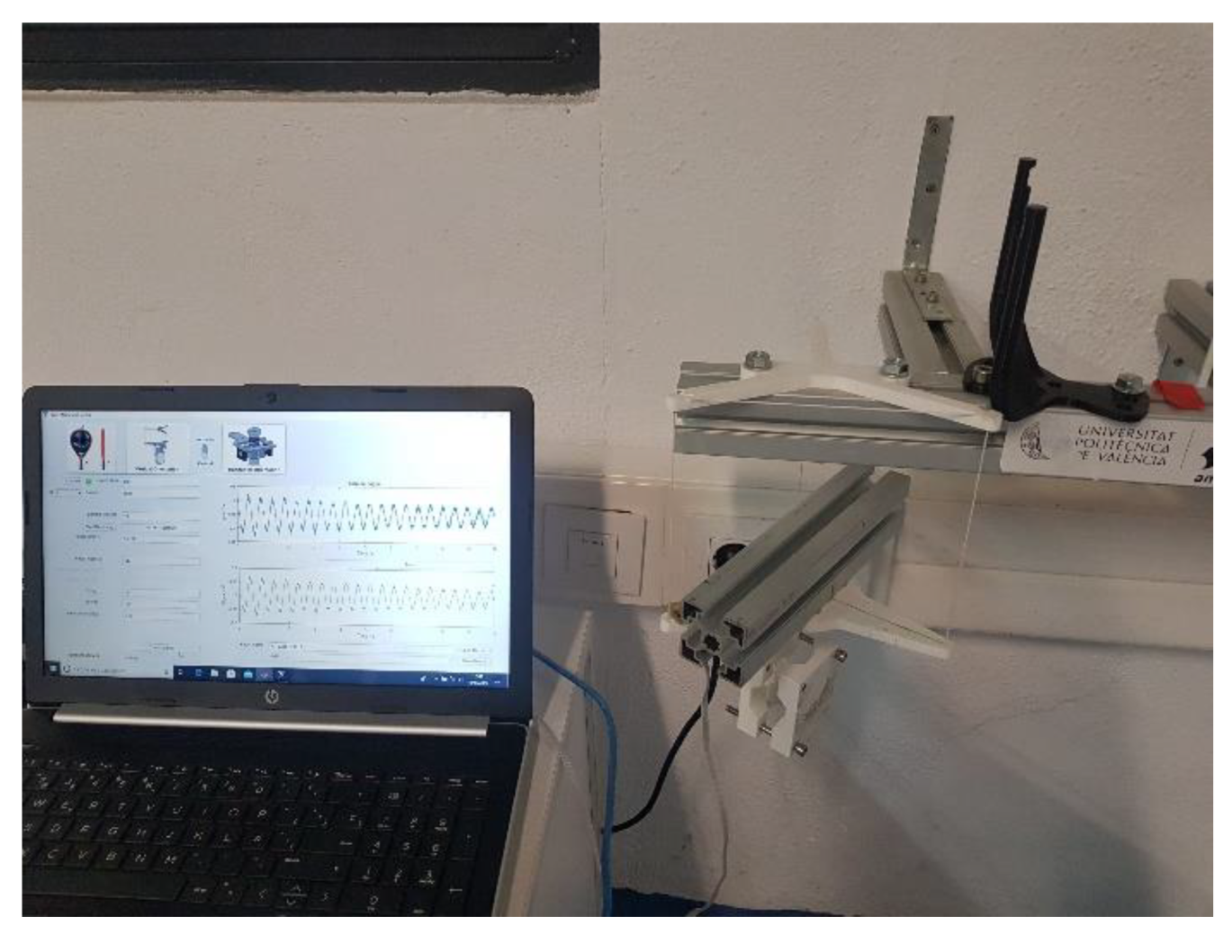


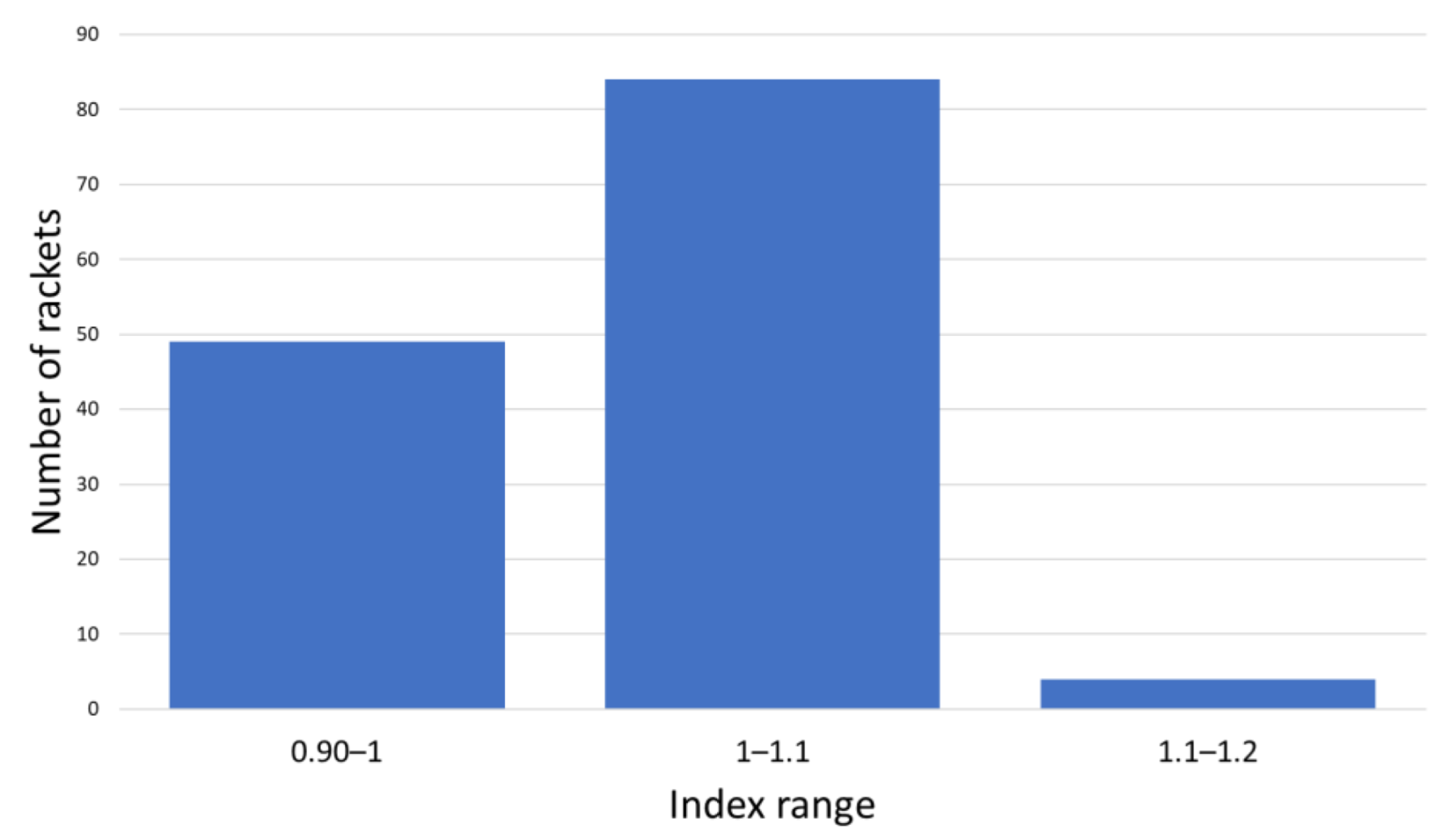
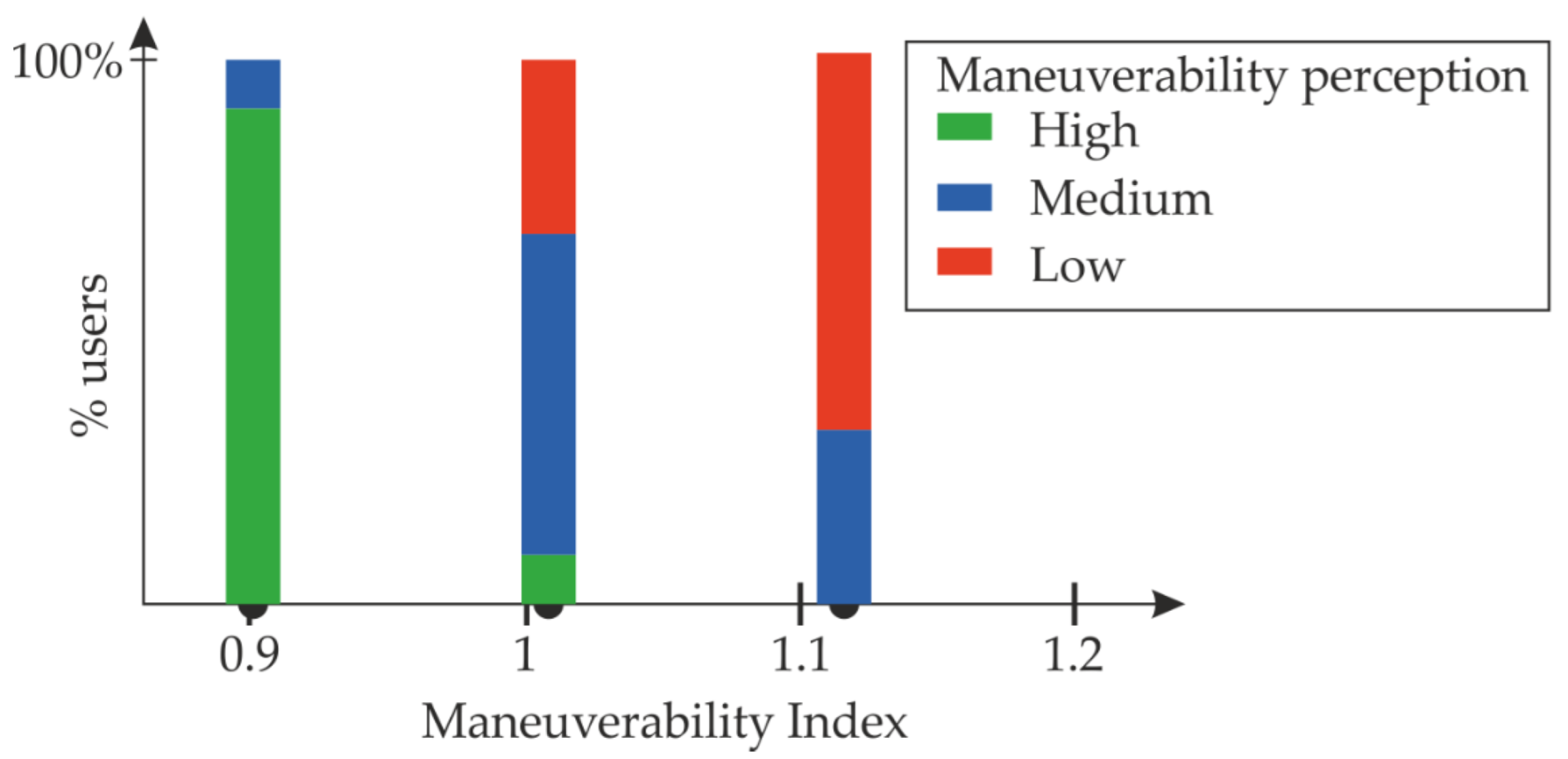
| Device | Advantages | Disadvantages |
|---|---|---|
| Atwood machine | Easy calculation | Long time for preparation Controllable motor recommended |
| Pendulum | Simple design | Different designs depending on the axis |
| Springs | Easy calculation Simple design | Spring characteristics must be determined |
| Parameter | xi | ∂I/∂xi | ∆xi | ∂I/∂xi∆xi10−4 |
|---|---|---|---|---|
| T | 1.103 s | 0.0485 | 0.00121 s | 0.587 |
| mr | 0.363 kg | 0.0736 | 0.000516 kg | 0.380 |
| dr | 0.265 m | 0.1007 | 0.000425 m | 0.428 |
| Model | Theoretical MOI X (kg cm2) | Measured MOI X (kg cm2) | MOI Standard Deviation | Accuracy Error (%) | Standard Deviation/Theoretical MOI (%) |
|---|---|---|---|---|---|
| a | 202.936 | 203.69 | 0.704 | −0.37 | 0.35 |
| b | 186.116 | 184.53 | 0.262 | 0.85 | 0.14 |
| c | 168.074 | 168.49 | 0.265 | −0.25 | 0.16 |
| Parameter | xi | ∂I/∂xi | ∆xi | ∂I/∂xi∆xi10−4 |
|---|---|---|---|---|
| T | 0.4829 s | 0.0084 | 0.00108 s | 0.0903 |
| T0 | 0.31008 s | −0.0016 | 0.0016 s | −0.0258 |
| mr | 0.3630 kg | 0.0039 | 0.000516 kg | 0.0201 |
| m0 | 0.1568 kg | 0.0023 | 0.000168 kg | 0.0039 |
| L | 0.1498 m | −0.0018 | 0.000087 m | −0.0015 |
| R | 0.10008 m | 0.0354 | 0.000174 m | 0.0607 |
| Model | Theoretical MOI X (kg cm2) | Measured MOI X (kg cm2) | MOI Standard Deviation | Accuracy Error (%) | Standard Deviation/Measured MOI (%) |
|---|---|---|---|---|---|
| A | 20.000 | 19.750 | 0.0777 | −1.14 | 0.39 |
| B | 17.506 | 17.527 | 0.0412 | −0.12 | 0.24 |
| C | 15.231 | 14.971 | 0.0412 | 1.71 | 0.28 |
| Test Stand | Error Propagation (%) | Accuracy Error (%) | Repeatability (%) |
| Horizontal | 0.418 | 0.491 | 0.215 |
| Vertical | 0.658 | 0.990 | 0.303 |
| Parameter | m (g) | dcom (mm) | Ix (kg cm2) | Iy (kg cm2) | Iz (kg cm2) |
|---|---|---|---|---|---|
| Avg | 363.07 | 265.52 | 190.599 | 202.027 | 17.282 |
| Min | 316 | 246 | 161.405 | 169.631 | 14.633 |
| Max | 387 | 283 | 209.869 | 224.166 | 19.812 |
| Padel Racket Index | High | Medium | Low |
|---|---|---|---|
| 0.90 | 91% | 9% | 0% |
| 1.02 | 9% | 59% | 32% |
| 1.12 | 0 | 32% | 68% |
Publisher’s Note: MDPI stays neutral with regard to jurisdictional claims in published maps and institutional affiliations. |
© 2022 by the authors. Licensee MDPI, Basel, Switzerland. This article is an open access article distributed under the terms and conditions of the Creative Commons Attribution (CC BY) license (https://creativecommons.org/licenses/by/4.0/).
Share and Cite
Blanes, C.; Correcher, A.; Beltrán, P.; Mellado, M. Identifying the Inertial Properties of a Padel Racket: An Experimental Maneuverability Proposal. Sensors 2022, 22, 9266. https://doi.org/10.3390/s22239266
Blanes C, Correcher A, Beltrán P, Mellado M. Identifying the Inertial Properties of a Padel Racket: An Experimental Maneuverability Proposal. Sensors. 2022; 22(23):9266. https://doi.org/10.3390/s22239266
Chicago/Turabian StyleBlanes, Carlos, Antonio Correcher, Pablo Beltrán, and Martin Mellado. 2022. "Identifying the Inertial Properties of a Padel Racket: An Experimental Maneuverability Proposal" Sensors 22, no. 23: 9266. https://doi.org/10.3390/s22239266
APA StyleBlanes, C., Correcher, A., Beltrán, P., & Mellado, M. (2022). Identifying the Inertial Properties of a Padel Racket: An Experimental Maneuverability Proposal. Sensors, 22(23), 9266. https://doi.org/10.3390/s22239266







